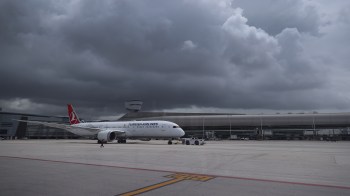A history of in-flight food
TEXT OF STORY
Bill Radke: OK. What do you say we take a break from the oil spill and hit the road? Today, we’re going to celebrate the industry we all love to contribute to — leisure travel. The summer vacation is making a comeback! The U.S. Travel Association estimates leisure air travel alone will cruise 8 percent higher this year. Now if only flying were the luxury it used to be. Remember when you could a get a free meal in coach?
Marketplace’s Rico Gagliano races the rise and fall of airplane food.
Rico Gagliano: In the early days of commercial air travel, passengers were less concerned with food than they were with reaching their destinations alive, so says Bob van der Linden. He’s a chairman at the Smithsonian’s National Air and Space Museum.
Bob van der Linden: The airline industry really took off, no pun intended, in the early 1930s. And airplanes were small, they were uncomfortable and you got bounced around the sky. So, airsickness was a problem and people really weren’t all that eager to eat.
Instead, van der Linden says, passengers would eat when the plane landed to refuel — assuming their trembling hands could still hold a fork. But eventually the first in-flight meal services began.
van der Linden: And usually they were box lunches, lotta fried chicken. I understand that was very popular. Easily done, it could last a while.
Gagliano: And healthy.
van der Linden: Yeah. They also handed out free cigarettes, so…
Gagliano: So you’re getting thrown around, you’re sick a lot, and you’re eating fried chicken and smoking.
van der Linden: Right — that’s air travel!
But only until the late 30s. Faster and better planes could fly higher and more smoothly. Airlines installed on-board kitchens. And in the years after World War II, the world entered the Golden Age of airplane food.
Pan Am promotional film: This is the atmosphere on a Jet Clipper flight. Delicious food adds to the enjoyment. It’s prepared in four simultaneously operating galleys, where dishes can be cooked in five-minute ovens.
You kind of have to see this promotional film from Pan Am to believe it.
It was shot in 1958. Attendants carry around platters laden with hors d’oeuvres. From carts, they serve heaps of brisket and carve off hunks of roast. Even economy-class passengers get big trays of piping hot grub.
Patricia: People treated it as a real experience. It was something really, really special.
Patricia Friend is president of the flight attendants’ union AFA-CWA. She was also a United Airlines attendant starting in 1966.
Friend: It was the very wealthy, really, who flew. And the airlines actually competed based on their in-flight service and how luxurious they could actually make it.
In fact, that’s the only way airlines could compete. Until 1978, the federal government strictly regulated air fares — every airline had to charge the same amount for a given route. Unable to offer lower prices, they had to offer better service.
But when Congress deregulated the industry? Friend says everything changed. Airlines rushed to cut fares. And to make up for the lost revenue, they slowly cut back on the luxury.
Friend: And I think if there was a sign, if you will, of times to come, it was at American Airlines, where they made this much ballyhooed decision to remove all of the olives on each small salad served in the economy cabin. And that was the beginning.
Alaska Air ad: These days a lot of airlines are cutting corners on their meals.
For the next 20 years, some airlines still tried to lure customers with the promise of bigger, or better, coach-class food.
Alaska Air ad: At Alaska Airlines, we spend a little more on our meals, and you can taste the difference.
But one event doomed the free airline meal pretty much for good.
Guillaume de Syon: 9/11, sadly.
That’s Guillaume de Syon. He’s an aviation historian and professor at Albright College.
de Syon: As airlines had to cut back their capacity considerably in the wake of 9/11, the tragedy became also a means to actually re-evaluate all the amenities that they were serving.
Toss in rising fuel prices, and soon airlines didn’t just shrink coach-class meals — they chucked them. And introduced BOB, aka “Buy on board” food. By that point, most passengers were fed up with the quality of free economy meals anyway.
de Syon: But there’s a paradox the airlines ignore. Is that when we get on board, we come to expect those silly peanuts or pretzels and that tomato juice. It’s a way to pass the time, quite literally.
Of course, the trade-off is cheap airfares. Today, a round-trip ticket from D.C. to San Francisco costs around 300 to 400 bucks. Back in 1938, that ticket cost about the same. You got a free meal, but for that money you could’ve also bought a car.
In Los Angeles, I’m Rico Gagliano for Marketplace.
There’s a lot happening in the world. Through it all, Marketplace is here for you.
You rely on Marketplace to break down the world’s events and tell you how it affects you in a fact-based, approachable way. We rely on your financial support to keep making that possible.
Your donation today powers the independent journalism that you rely on. For just $5/month, you can help sustain Marketplace so we can keep reporting on the things that matter to you.


















